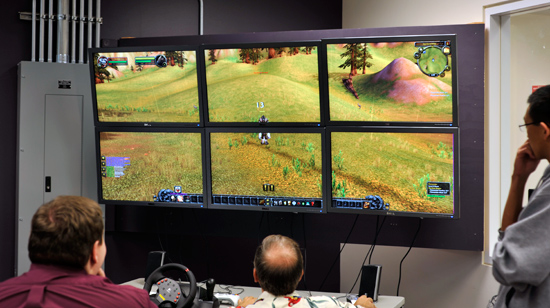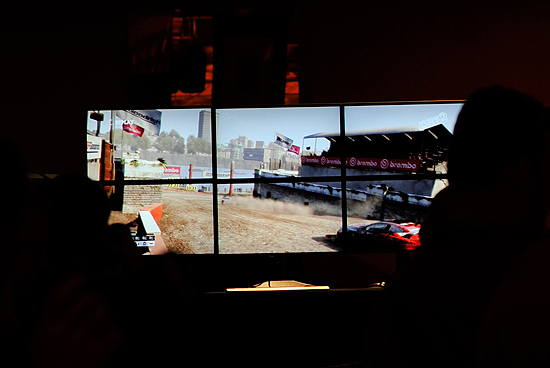Beginnings of the Holodeck: AMD's DX11 GPU, Eyefinity and 6 Display Outputs
by Anand Lal Shimpi on September 10, 2009 2:30 PM EST- Posted in
- GPUs
The First Generation Holodeck by 2016
When AMD first told me about the RV770 they told me another interesting story. For the past several years AMD (and ATI before it) has been obsessed with trying to figure out when it would be possible to render an image so convincing that it was indistinguishable (at least mostly) from reality.
Given the right art and a good technique to render the scene, this is totally possible not only within our lifetimes but within the next decade. Unfortunately, that's not enough.
Carrell estimates that the human eye can directly resolve around 7 million pixels, almost twice the resolution of a 30" display. But that's just what it's directly focusing on, all of the peripherial vision brings the total up to around 100 million pixels. The Eyefinity demo I showed earlier was running at 24.5 million pixels on a single GPU; you can estimate that at this generation we'll be able to do about 50 million pixels with two GPUs and one more generation from now we'll get to that 100 million pixel marker. That's two years for a single GPU. Then give it a few more years to be able to render that many pixels but with enough complexity to actually look real.
Rendering something at the max resolution that the human eye can resolve isn't enough however; you have to feel immersed in the graphics. That's where Eyefinity comes in, at least what it starts to come in.
Carrell believes that in seven years we can have the first generation Holodeck up and running. For those of you who aren't familiar with the Trek reference, Carrell believes it'll take seven years to be able to deliver a 180 degree hemispherical display (you're not completely surrounded by displays but at least your forward and peripheral vision is) with positionally accurate and phase accurate sound (both calculated by the GPU in real time). The GPU will also be used to recognize speech, track gestures and track eye movement/position.
It doesn't solve the issue of not being able to walk forward indefinitely, but again this is only the first generation Holodeck.
Eyefinity isn't anywhere close, but if you understand the direction: it's a start.

We're at six 2560 x 1600 displays today, is it too far fetched to imagine a totally immersive display setup that renders at life-like resolutions?
First person shooters pretty much dictate that you'll need an odd number of displays to avoid your crosshairs spanning multiple monitors. With three displays you can begin to get the immersion effect, but buy five and you'll be completely surrounded by your game. And as I mentioned before, it doesn't require any special application or OS support, the drivers take care of everything: it just appears as a single, large, surface.
It seems trivial but honestly we haven't had the ability to easily support the ridiculous display setups we always see in sci-fi movies. Eyefinity at least makes it look like we can build the PCs from the Matrix.
Will it succeed? Who knows. Does it sound gimmicky? Sure. Is it cool? Yeah, I'd say so.

If panel prices could drop significantly enough where putting together an Eyefinity display setup didn't cost more than the graphics card, I think it'd be a much easier sell. Obviously AMD's next-generation GPU is more than just Eyefinity, but you'll hear about the rest late this month.










137 Comments
View All Comments
Deke2009 - Sunday, September 20, 2009 - link
will we be able to align displays simular to matrox's triplehead2go?TheOtherMrSmith - Saturday, September 19, 2009 - link
If you want to see a really interesting monitor design that could really benefit from this new video card tech, check out NEC's new goods:
# 42.8" diagonal
# 2880 x 900
# 0.02 ms. response time
# 12-bit color range
http://www.homotron.net/2009/01/macworld_2009_nec_...">http://www.homotron.net/2009/01/macworld_2009_nec_...
This thing is really amazing!
Deke2009 - Sunday, September 20, 2009 - link
woohoo 900 vertical res, what a piece of crapvol7ron - Tuesday, September 15, 2009 - link
Once man can harness the capability of rearranging matter (elements, protons, neutrons, etc), this graphical hologram will be a thing of the past.All that we'll need to do is provide existing matter and the technology will be able to break it down and reconfigure it to another molecular structure. Thus, changing trash into food.
In coordination with that, the real holodeck will do the same thing, but instead of making food, it'll make people and inanimate objects. However, a computer program will track what it's made so that it can't "hurt" real humans.
That is the wave of the future, which may very-well be possible with metaphysics.
JonnyDough - Monday, September 14, 2009 - link
Samsung was a great choice.I <3 AMD.
I wonder what the power draw on the entire system, including monitors was. There's a gray fuse box right next to the monitors...yikes!
AnnonymousCoward - Monday, September 14, 2009 - link
Here's your damn holodeck. 6-sided fully enclosed cube, 16.8MP per wall, in 3D. http://www.vrac.iastate.edu/c6.php">http://www.vrac.iastate.edu/c6.php I've been in it.I'm surprised there's no mention of HDR. That's what's required for images to be indistinguishable from reality. Without HDR, all the new game engines, megapixels, and multi-monitors won't get you there.
ProDigit - Saturday, September 12, 2009 - link
I think instead of focusing on millions of millions of pixels that the eye will not be able to perceive, why not focus on widescreen, high resolution glasses?To see a single image (does not even need to be 3D) through glasses, and when rotating the head, the display rotates too (but the controller,mouse or keyboard controls the direction that the in game character faces).
Why spend precious resources on:
- First of all pixels we're not able to perceive with the eye
- Second of all, when we focus to the right with our eye, why render high quality images on the left monitors (when we're not able to see them anyways)?
Makes more sense to go for glasses.
,or, some kind of sensor on the head of the player,that will tell the pc, where to focus it's graphics to.
Images shown in the corner of the eye, don't need highest quality, because we can't perceive images in the corners as well as where we focus our eyes to.
Second of all;it would make more sense spending time in research on which monitor is the ultimate gaming monitor?.
The ultimate gaming monitor depends on how far you're away from the monitor.
For instance a 1920x1080 resolution screen might be perfect as a 22" monitor on a desk 2 feet away,while that same resolution might fit an 80" screen 10 feet away.
There is need for researching this optimal resolution/distance calculation, and then focus on those resolutions.
It makes no sense to put a 16000 by 9000 resolution screen on a desk 3 feet away from you,and will take plenty of unneccesary GPU calculations.
lyeoh - Saturday, September 12, 2009 - link
In practice, the "Single Large Surface" approach will not be as good as the O/S being aware of multiple monitors.Why? Because the monitors do not present a single contiguous display surface - there are gaps. So if the O/S isn't aware, in certain monitor setups it's going to plonk a dialog box across a boundary or more, making it hard to read. And when you maximize a window it gets ridiculous. I don't think it helps to have your taskbar stretched across 3 screens either..
Nvidia actually does let you treat two displays as one (span mode), but they also allow you to expose them to windows (dual view). And I prefer dual view to span, and don't have many problems with it.
I can quickly move windows to different monitors with hotkeys (or just plain mouse dragging). The problem I have is moving "full screen" stuff to different monitors usually doesn't work.
"Single Large Surface"/span mode is actually going to be suboptimal for most users. Just a kludge to support OSes that can't handle 6 displays in various configs.
kekewons - Saturday, September 12, 2009 - link
FWIW, I suspect SLS will incorporate some sort of "hard frame" adjustment...if only because freeware "multimonitor" solutions like SoftTH already do so even now.But, at the same time, I'll also say I wouldn't be surprised to see this driver team miss out completely, re: a version 1.0 release.
Because it's happened before......
snarfbot - Friday, September 11, 2009 - link
um projectors?buy 6 cheap led projectors, 800x480 resolution each, easily make a surround setup with it too.
best part is no bezels. thats the ticket.